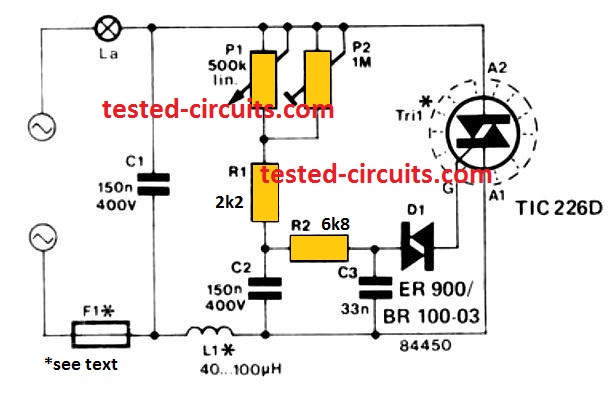This mains AC triac light dimmer circuit can be used for controlling all high watt lamps from 100 watt to 1000 watt through an ordinary potentiometer adjustments. You can also control heater elements upto 1 kilowatt, and even upgrade the triac for higher ranges up to 2000 watts
The majority of light dimmers widely available in the typical electrical commodities retailers can only manage a reasonably small power doads.
A few hundred watts is normally the restriction and the possibility of getting the specific which can control up to a half kilowatt or so is actually hard.

The simple dimmer circuit demonstrated in this article will be able to control a power of up to 1 kW. There isn’t a lot to be explained about the details of the circuit.
It includes one power triac, one diac and an RC configuration where the charging and discharging periods of capacitor C2 could be fixed with potentiometer P1. Electrical surges are kept in check by capacitor C1 and inductor L1.
The calibration procedure requires adjusting P1 to optimum resistance and then fine tuning the preset P2 so that the lamp is just glowing.
If a lamp greater than 100 W is used make sure the triac is installed on a heatsink having a heat exchange rate of approximately 6 °C/W. For a 1000 W dimmer, suppressor coil L1 should be selected to have a 5 A (the inductance can be around 40 uH) and the fuse F1 could be rated at 6.3 amps.
¡Gracias!
Todos los circuitos muy útiles e interesantes.
Hi,
Kindly. how can one use this circuit to control 3.5kW>4kW heating element, using just a higher current Traic? Obviously with a heatsink.
What span will one have on the variable potentiometer? 1kW min and 3.5kW maximum?
Hey Hermann,
Yes, you can use it to control 4kW just by upgrading the triac appropriately, and nothing else needs to be changed.
The exact range is not known to me, you may have to verify it practically…